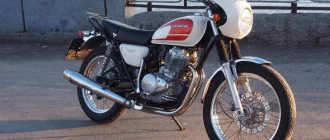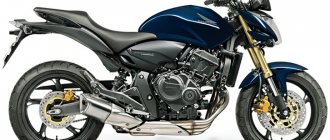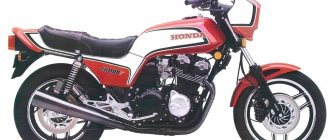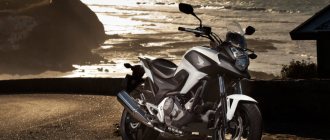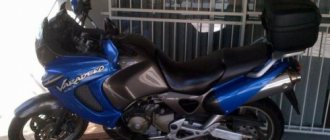The Japanese manufacturer Honda is well known in the motorcycle market to both professional riders and ordinary amateurs. Models of this brand are distinguished by the reliability of their components, powerful engines and original design. Some families of motorcycles have several generations, which confirms the high quality of these products. This series can also include the Honda VTR 250 model, the photo of which is presented below.
General information about the motorcycle
The model represents the classic performance of a road motorcycle. The development entered the market in 1997 and was aimed primarily at the Asian market. However, in 2009, the bike became available to Europeans, which motivated the creators to continue the development of the family. The design and overall construction of the model was initially distinguished by the presence of sporting features, which were interspersed with off-road characteristics. It is enough to note the slightly raised tail section and the dashboard, which looks reminiscent of the Italian Ducati-Monster line. But at the same time, the model also embodies many original qualities, which a review of the Honda VTR 250 and its technical and operational data will help you understand.
Photos
Brief review of Honda VT 250 Spada
Honda VT 250 Spada is a small-capacity road motorcycle produced at the turn of the 80s - 90s of the last century and sold exclusively in the Japanese domestic market. However, a number of copies of this model still ride on Russian roads, since the motorcycle has excellent endurance, especially for a modest and inexpensive 250 cc model. During the years of its release it was not very popular, but subsequently it was on the basis of the Honda VT 250 Spada that another model was developed - the Honda VTR 250.
The striking difference between the Honda VT 250 Spada and other small-capacity road cars of the same production years lies in the engine - Japanese designers installed a very powerful V-twin in a technologically advanced diagonal frame. Like all souped-up small-capacity motorcycles, the Spada loves high revs, but at the same time it produces excellent power for 250 cc. see working volume characteristics. At the same time, a powerful engine and a well-designed frame are combined with rather primitive suspensions that are not very suitable for an aggressive driving style.
- Yamaha FZX250 Zeal
- Suzuki GSF250 Bandit
- Kawasaki Balius 250
Specifications
The device has a traditional design, which ensures its practicality and reliability in operation. Again, the high service life of the parts, coupled with the original frame configuration, also affected the user-friendliness. Now you can take a closer look at the parameters of the Honda VTR 250. The technical characteristics of the motorcycle look like this:
- Dimensions – 204 cm in length, 72 cm in width and 105 cm in height.
- The height of the bike at the saddle is 78 cm.
- Ignition type – transistor.
- The gearbox is five-speed.
- Drive type – chain.
- The front brakes are 29.6 cm discs with a two-piston caliper.
- The rear brakes are disc brakes with a single-piston caliper.
- Front suspension - 4.1 cm with a telescopic fork of the Shova brand.
- The rear suspension of the motorcycle is implemented with a monoshock absorber with a progression of the Pro-Link system.
- Fuel tank capacity – 13 l.
- Weight – 139 kg.
Chassis and brakes
The steel frame of the VTR 250 is a birdcage type. She looks quite stylish and interesting. The wheels here are more expressive than those of its predecessor: the cast elements are straight and minimalistic, but there are more of them, and they are located more elegantly.
The rear suspension is a monoshock with progression, and the front suspension is a 41 mm telescopic fork. Discs are used as brakes both front and rear, with the only difference being that the front part of the bike has a two-piston caliper, and the rear part has a single-piston caliper.
Characteristics of the power unit
The bike is equipped with a two-cylinder four-stroke engine, the output of which, with a volume of 249 cm 3, is 30 liters. With. There are conflicting opinions regarding the performance and thrust of the installation. On the one hand, the latest generations of the model demonstrate an order of magnitude higher productivity than previous generations. On the other hand, in the general segment, in terms of these indicators, the unit seriously loses to its competitors. This is largely due to the modest displacement of the 250 VTR engine. Honda notes that despite the low initial data, the power plant is still reliable and trouble-free in operation. And the practice of users, by the way, confirms this. In addition, experienced riders point to another positive aspect of using a low-performance engine - economical gas mileage. So, according to official data, the bike consumes only 2.5 liters per 100 km. Motorcycle owners talk about 3 liters on average, but this value also makes the model profitable in terms of fuel costs.
Control and dynamics
The model feels confident in its natural environment – on the road surface. The device is not suitable for racing and off-road racing. A reliable motor ensures coordinated operation of the internal filling, which allows you to feel comfortable while moving. For this reason, many consider this motorcycle almost ideal for a novice rider. At the same time, the Honda VTR 250 has good dynamics – the maximum speed and acceleration characteristics are 160 km/h and 8 seconds to 100 km/h, respectively. It is worth noting that to increase safety when driving at high speeds, it is recommended to purchase a windshield. According to many owners, this accessory spoils the appearance of the bike, but for the sake of practicality and safety, it is better not to ignore such recommendations.
Review of the Honda VTR 250 motorcycle
The first thing that struck me was the dynamics! The kid “knocked down” from the very bottom) Knocked down - taking into account the cubic capacity of course) At that time, my brother had a 1998 Yamaha XJR 400, and so - up to 80-90 km/h, he and I walked on equal terms in a straight line!) And this at the same time that I had 20 horses less! And at the start, I even left him. Although, of course, the motorcycle is not the fastest - mine accelerated to hundreds in about 8 seconds. The maximum I drove on it was 150 km/h according to the speedometer. Although in fact it was comfortable to drive it only up to 100 km/h, then it began to blow away with a tailwind. What else struck me about this blue baby - as they say, “he didn’t eat, but sniffed” gasoline))) On the highway at cruising 80-100 km per hour, the consumption was 3-3.5 liters per hundred approximately) A 12-liter tank was enough in a combined cycle for 250-280 km, and there was still something splashing in the tank!) And sometimes at traffic lights I liked to unscrew the throttle) With my height of 175 cm, despite the seemingly small size of the motorcycle, I didn’t feel any discomfort) my back didn’t go numb, my hands didn’t hurt) I also forgot to mention that the previous owner installed a wider rear tire, so the rear view was very “sexy,” and the bike held the road more steadily and didn’t slide into a rut. And the sound of the engine and exhaust simply put me in a romantic mood! The baby droned like a real little Harley!!! What I also really liked was that you could get underway even in 2nd gear) The engine pulled from the very bottom! And it was fun to come out of the turn after braking and gradually accelerate in 3rd gear, the sound pleasantly caressed the ears!) I drove it for about 3000 km, from the investment I changed the oil and pads, and rebuilt the fork. The fork was snotty, I immediately sent it to be rebuilt - it turned out that the seals in it had never been changed since the factory))) And they simply rotted, which is why the oil started snotty) There were absolutely no more problems! The motorcycle only made me happy. Realizing that I had already grown out of it, I sold the motorcycle in the fall; the current owner rides it to Ukhta. We also communicate with him sometimes - the motorcycle makes his wife happy, I recently uploaded a video with him, I almost shed a tear).
Well, what would I like to sum up: despite the fact that the motorcycle has a small capacity, it is quite powerful, inexpensive to maintain, very reliable, and looks very stylish. Don’t be afraid to take it if you have any doubts - you won’t regret anything! It steers like a bicycle!
I bought a three-wheeler a year ago, I still have nothing against it, the motorcycle is just super, the traction even for a 250 is very good, many people say they don’t like twins, it’s all nothing, I tried to race with the new 250cc ninja, which has 33 hp until the 2nd gear, then everything was driving, as if the Hayabusa was pushing me from behind and passed it) I’m not a meter behind about 400, especially at the maximum speed, although when switching to 5th the motorcycle starts to ride very sluggishly, but I tried to measure this after 150 km.h max speed, goes 195 km/h, the 750th bandit was driving next to me, the downsides are the small paws of both braking and shifting, a weak generator and a quiet standard sound, otherwise the engine is ideal.
I had a short acquaintance with this motorcycle. I dreamed about it for a very long time, but in the end I didn’t buy it, not because it was bad, but because the copy I got was substandard (the brake disc was damaged and the color was silver, it doesn’t suit it in my opinion), and I already had the money...
At that time I was driving a Honda CBR150R and was already thinking about something bigger. So I started chasing the VTR250, which at that time was a very rare guest in our area. Once I almost drove it from St. Petersburg, but there wasn’t much of an option there either, and it was scary to drive it.
What can I tell you about the motorcycle in general? This, in my opinion, is simply an ideal option for a beginner. And that's why. Firstly, it’s still 250cc, so you won’t get bored on the first day, unlike the boring YBR125. Secondly, it’s a V-Twin = traction, at the bottom it’s no worse than an inline four hundred () if you don’t rush! And what a design! No, it's not design, it's style!
Well, in general, the VTR250’s engine is good, reliable, like the rest of the motorcycle, comfortable for riding, but not for racing. So don’t expect bullet dynamics from it, although again, it’s enough for beginners or for the city. According to the passport, by the way, acceleration to 100 km/h takes 8.3 seconds. Maximum speed is 160 km/h, fuel consumption is 3.5-4 l/100 km.
Yes! Of course I forgot about the mass. The Honda VTR250 is a very light motorcycle, which is important for beginners and girls, and generally convenient. To summarize, I can only wholeheartedly recommend this motorcycle for purchase. Another argument in its favor will be the price. It’s autumn now and it starts from 85 thousand rubles. In the season from 90-100 for a motorcycle produced in 1998. And for 120 you can find a 2003 model, which has a more complete instrument panel with a tachometer in chrome glasses. Well, what other motorcycle from 2003 would you buy for 120 thousand? So, in my deep conviction, the Honda VTR250 will be an excellent first motorcycle and quite an alternative to the classic in-line fours.
Modifications
Since the appearance of the motorcycle on the European market, the Japanese have updated the model several times, including increasing power. One of the most striking modifications is the VTR-F 250 version, in which the features of Italian bikes are most pronounced. True, the creators decided to leave the engine the same – with a power of 30 hp. With. Despite the similarity with Ducati models, the new version of the 250 VTR Honda is distinguished by its modest price tag, reliability and ease of maintenance. New technologies can also be seen in this device. In particular, the motorcycle received a liquid crystal display, above which, however, there is the usual stopwatch and tachometer in an analog version. As for structural improvements, the engineers reduced the saddle height to 74 cm. This is especially valuable for short riders. The latest developments in motorcycle technology have also appeared in the form of a catalytic converter with two oxygen sensors. The introduction of these systems was caused by the desire to comply with new environmental requirements.
Positive reviews about the motorcycle
The motorcycle segment was very dynamic even decades ago, but today some of its niches are completely taken over by fundamentally different categories of individual transport. However, there are many dedicated connoisseurs of classic road bikes. This category of users primarily notes the external data of the 250 VTR. Honda has retained the general design style, for which this model is mainly appreciated. Users place reliability and durability in second place on the list of advantages of this bike. Confirmation of the high resource of the element base is more than 10 years of operation of such motorcycles without major interventions in the design. Another thing is that many riders decide on tuning updates in accordance with the latest fashion. And from the point of view of modifications, the Japanese motorcycle also acts as a completely friendly base.
Bike features
Here are the main features of the Honda VTR 250:
- the model is very similar to the Ducati Monster;
- the motorcycle prefers high speeds;
- significant dynamics within the class.
The bike occupies a place of honor in its category, and considering how many years have passed since its release, it can be said that it has made a significant contribution both to the motorcycle industry and to the very idea of what a typical road bike should look like.
Negative reviews
If you strictly approach the assessment of the model in the context of the capabilities of modern motor vehicles, you can find many weaknesses. This mainly concerns the power filling, the power of which only in some versions exceeds 30 hp. With. As the owners emphasize, this potential significantly limits the performance of the bike. At the same time, the outdated ergonomics of the Honda VTR 250 are also noted. Reviews, for example, criticize the creators for their reluctance to use electronic systems in new versions.
Specifications
Technical characteristics of Honda VT 250 Spada:
| Model | Honda VT250 Spada |
| Motorcycle type | naked |
| Year of issue | 1988-1990 |
| Frame | aluminum diagonal |
| engine's type | 2-cylinder, V-shaped (52°), 4-stroke |
| Working volume | 249 cm³ |
| Bore/Stroke | 60.0 x 44.1 mm |
| Compression ratio | 11.0:1 |
| Cooling | liquid |
| Number of valves per cylinder | DOHC chain drive, 4 valves per cylinder |
| Fuel supply system | Carburetor, x2 Keihin, 34.4 mm |
| Ignition type | CDI |
| Maximum power | 40.0 hp (29.4 kW) at 12,000 rpm |
| Maximum torque | 25.0 Nm (2.6 kg*m) at 9000 rpm |
| Transmission | 6-speed |
| type of drive | chain |
| Front tire size | 100/80-17 (52S) |
| Rear tire size | 140/70-17 (66S) |
| Front brakes | 1 disc, 296 mm, 2-piston caliper |
| Rear brakes | 1 disc, 220 mm, 1-piston caliper |
| Front suspension | Telescopic fork 37 mm |
| Rear suspension | Pendulum with monoshock absorber |
| Motorcycle length | 2010 mm |
| Motorcycle width | 715 mm |
| Motorcycle height | 1020 mm |
| Wheelbase | 1380 mm |
| Seat height | 740 mm |
| Minimum ground clearance (clearance) | 150 mm |
| Acceleration to 100 km/h | 8.0 sec. |
| Maximum speed | 180 km/h |
| Gas tank capacity | 11.0 l (including reserve - 2.0 l) |
| Motorcycle weight (dry) | 140 kg |
| Motorcycle weight (curb) | 153 kg |
Honda VTR250
Honda VTR250 - photo 1
Honda VTR250 - photo 2
Honda VTR250 - photo 3
Honda VTR250 - photo 4
Honda VTR250 - photo 5
| Model | Honda VTR250 |
| Motorcycle type | road (street, naked) |
| Year of issue | 1997-present vr. |
| Frame | steel, birdcage |
| engine's type | 2-cylinder, 4-stroke, V-shaped (90°) |
| Working volume | 249 cc cm. |
| Bore/Stroke | 60 x 44 mm |
| Compression ratio | 11,0:1 |
| Cooling | liquid |
| Number of valves per cylinder | DOHC, 4 valves per cylinder |
| Fuel supply system | carburetors 2x 32mm VD10 (since 2009 - PGM-FI injector) |
| Ignition type | transistor |
| Maximum power | 32 hp at 10500 rpm |
| Maximum torque | 23.5 Nm at 8500 rpm |
| Transmission | 5-speed |
| type of drive | chain |
| Front tire size | 110/70-17 |
| Rear tire size | 140/70-17 |
| Front brakes | 1 disc, 296 mm, 2-piston caliper |
| Rear brakes | 1 disc, 1 piston caliper |
| Front suspension | 41mm Showa telescopic fork |
| Rear suspension | Monoshock absorber with Pro-Link progression (preload adjustment) |
| Maximum speed | 150.0 km/h |
| Acceleration to 100 km/h | 8 sec |
| Dimensions (length, width, height) | 2040, 720, 1050 mm |
| Seat height | 780 mm |
| Gas tank capacity | 13 l (since 2009 - 12 l) |
| Motorcycle weight (dry) | 139 kg |
The officially declared fuel consumption for the Honda VTR 250 is 2.5 liters per 100 km.
The actual consumption value, according to owners, is 3-3.5 liters per 100 km. The price for a Honda VTR 250 in good technical condition, without mileage in the Russian Federation, is in the range of $2500-3000. The cost of models with mileage in the Russian Federation starts from 120,000 rubles.
Technical characteristics of Honda VT 250 Spada:
| Model | Honda VT250 Spada |
| Motorcycle type | naked |
| Year of issue | 1988-1990 |
| Frame | aluminum diagonal |
| engine's type | 2-cylinder, V-shaped (52°), 4-stroke |
| Working volume | 249 cm³ |
| Bore/Stroke | 60.0 x 44.1 mm |
| Compression ratio | 11.0:1 |
| Cooling | liquid |
| Number of valves per cylinder | DOHC chain drive, 4 valves per cylinder |
| Fuel supply system | Carburetor, x2 Keihin, 34.4 mm |
| Ignition type | CDI |
| Maximum power | 40.0 hp (29.4 kW) at 12,000 rpm |
| Maximum torque | 25.0 Nm (2.6 kg*m) at 9000 rpm |
| Clutch | Multi-disc in oil bath, cable drive |
| Transmission | 6-speed |
| type of drive | chain |
| Front tire size | 100/80-17 (52S) |
| Rear tire size | 140/70-17 (66S) |
| Front brakes | 1 disc, 296 mm, 2-piston caliper |
| Rear brakes | 1 disc, 220 mm, 1-piston caliper |
| Front suspension | Telescopic fork 37 mm |
| Rear suspension | Pendulum with monoshock absorber |
| Motorcycle length | 2010 mm |
| Motorcycle width | 715 mm |
| Motorcycle height | 1020 mm |
| Wheelbase | 1380 mm |
| Seat height | 740 mm |
| Minimum ground clearance (clearance) | 150 mm |
| Acceleration 0-100 km/h (0-60 mph) | 8.0 sec. |
| Maximum speed | 180 km/h |
| Gas tank capacity | 11.0 l (including reserve - 2.0 l) |
| Motorcycle weight (dry) | 140 kg |
| Motorcycle weight (curb) | 153 kg |
The Honda Interceptor VTR250 was sold only in the United States from 1988 to 1990, with moderate changes occurring over the three model years. With a 249 cc (15.2 cu in) four-stroke liquid-cooled DOHC V-twin engine and a six-speed transmission, the VTR250 was the smallest of Honda's Interceptor line of motorcycles.
The 1990 model had a 17-inch front wheel and the front disc brakes were external.
Video
I found a very interesting article about Vetashka =)
It is not possible to review the entire Honda model range in a small article. And therefore, let’s focus our attention on one of the most interesting models, well-known and quite popular in the city. Honda VT 250. But... It was not in vain that we suggested stopping our gaze. In other words, just look. It is unknown what feelings this process will evoke: silent delight, rapturous awe or sincere bewilderment, but it is certain that no one will remain indifferent. The predatory, even aggressive profile of a sportbike, the high ground clearance of a road bike and the wide, coquettishly raised pipes, which are more characteristic of a classic bike, make it difficult to classify it into any category. The universality of use also does not add clarity to this issue. “Veteha” feels equally good on the highway, reaching speeds of up to 180 km/h (this is according to the speedometer, but in order to “fill up” the needle, you still need to accelerate), in the forest, where the long stroke of the shock absorbers allows it to even jump, and in the city , where its legendary maneuverability is simply irreplaceable. A high-speed neoclassic with the capabilities of an SUV is perhaps its most accurate definition. However, let's not lie. Any definition suffers from limitation. Ours, alas, is no exception.
Basics Now let's see what we have to deal with. The basis of any self-propelled vehicle is the engine. The Honda VT250 is equipped with a V-shaped (90 degrees) two-cylinder 4-camshaft 8-valve engine with liquid cooling and a 6-speed gearbox. Power – from 36 to 43 hp. depending on the model. I must admit, quite a good distribution of torque and power. It starts to pull almost from idle, a pleasantly surprising moment at medium and a calm pull up to 13,000 rpm. By the way, this is what allows you to safely drive both through the forest and off-road, as well as on the highway and on long trips. Frame – chrome-molybdenum solid-drawn tube, complex duplex. On the left is a removable section for removing the engine. This section of the frame also supplies coolant from the radiator to the pump, which reduces the length of the rubber pipe. The pendant deserves special mention. There are hydropneumatic fork stays at the front, Pro-Link at the rear (suspension with progressive characteristics) with a WP hydropneumatic monoshock absorber. The ability to pump air allows you to adjust the height of the rear shock absorber depending on the presence of cargo, passengers and the nature of the terrain. Brakes. Single-disc, two-piston ventilated Inboard brake at the front (a disc in the form of a ring secured by the outer diameter, the pads “grab” the disc from the inside and stand “inside” the ring) and a small-diameter drum brake at the rear. And finally, the wheels. They are prefabricated, Komstar systems (a disc turned and hardened from an aluminum-magnesium alloy, to which three pairs of boomerang-shaped plates are riveted, and a hub is already riveted to them). Such wheels are almost not afraid of impacts, and their weight is almost the same as cast ones. They stopped installing them, but not because of the backwardness of the design, but because of the complexity and high cost of manufacturing. It's a pity!
Protection and ergonomics No matter how unimportant the characteristics in the title may seem to some, we would venture to suggest that this is not entirely true. Minimum requirements for the safety and comfort of a motorcycle driver (we will refrain from defining “biker” or “motorcyclist”, too delicate a subject) are extremely necessary. Also because in relation to a motorcycle it is, without exaggeration, a matter of life and death. That is why Honda designers, like no one else, are concerned with this issue and their achievements in this area are obvious. The presented model clearly shows concern not only for safety while driving, but also for the moment when this movement is interrupted not at all by the will of the driver. The first is wind protection. She is really competent and thoughtful on a motorcycle. Despite its small size, it performs all the functions assigned to it. True, at a speed of over a hundred, the wind still makes life noticeably more difficult. And when accelerating to 150, in order to hide from oncoming traffic, it is best to just lie on the tank. In the event of a fall (of course, at low speed, for example, when turning), the driver has every chance of keeping his legs relatively intact. The fact is that installing iron tips on the steering wheel handles and bending the exhaust pipes leaves the driver’s foot in a deep niche when he falls. Without this, all 160 kg of metal would have neatly settled on the ankle, the sad consequences of which are easily predictable. And so everything is more or less safe. And some other little things. So, the motorcycle engine will not start if the speed is turned on. And if, on the contrary, the speed is too high (beyond 90 km/h), the red light on the instrument panel begins to blink. It does not interfere or distract, but its irritating effect makes you remember about safety. And maybe slow down. Speaking of the instrument panel. This is not to say that she is too rich. But quite informative and easy to read. Along with the obligatory speedometer, calibrated to 180 km/h, there is a tachometer (marked up to 13,500) and an engine temperature indicator. Plus, a number of lights indicate the neutral position of the gearbox, oil pressure, overspeed (!), and the inclusion of lights and turn indicators. The turn signals themselves are successfully mounted into the semi-fairing and rear pylon. Nothing sticks out, doesn’t stick out and, most importantly, doesn’t break when dropped.

